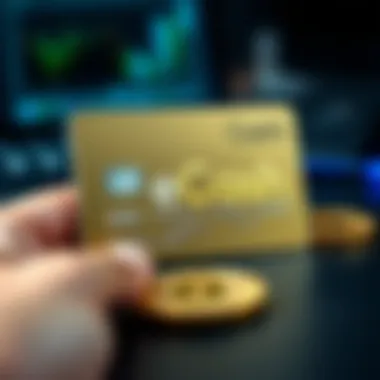The eCash Card: A Comprehensive Guide to Digital Currency


Intro
In an age where digital transactions are more than just a convenience, they have become essential to everyday commerce. A pivotal player in this arena is the eCash Card. It stands as a testament to the ever-evolving nature of financial technology. By merging ease of use with robust security features, the eCash card not only facilitates transactions but also signifies a shift towards a more fluid and decentralized financial system. This guide aims to shed light on the intricacies of the eCash card, its functions, and its impact on the broader cryptocurrency landscape, offering insights that range from mechanics to potential market consequences.
Understanding Cryptocurrency Fundamentals
Before delving deep into the workings of the eCash card, it’s crucial to grasp the basic concepts of cryptocurrency that lay the groundwork for such an innovation.
What is Cryptocurrency?
Cryptocurrency, at its core, is a form of digital or virtual currency that uses cryptography for security. Unlike traditional currencies issued by governments, cryptocurrencies are decentralized and often operate on technology known as blockchain. Their nature allows for peer-to-peer transactions without needing a central authority, like a bank. This autonomy is what makes cryptocurrencies appealing, and the eCash card capitalizes on this foundational principle, offering a tangible way to utilize digital currencies in daily transactions.
Cryptocurrency includes various forms, such as Bitcoin, Ethereum, and many others, each created with distinct algorithms and purposes. Some aim to be digital cash, while others serve as platforms for smart contracts or decentralized applications. The variety in this space keeps it dynamic and constantly evolving, pushing the boundaries of how we perceive money.
How Blockchain Technology Works
Blockchain technology serves as the backbone of most cryptocurrencies, including the eCash card. So, how does it all work?
- Decentralization: Blockchain operates on a distributed ledger system. Each participant in the network holds a copy of the entire ledger, preventing single points of failure or control.
- Immutability: Once recorded, transaction data cannot be altered. This characteristic enhances trust in the system, as each transaction is clear and verifiable.
- Consensus Mechanisms: Transactions are validated through various protocols, ensuring that all copies of the ledger remain in sync without a need for a central authority. This includes mechanisms such as Proof of Work or Proof of Stake.
Such technology allows the eCash card to perform transactions that are both efficient and secure. Traditional means of transaction can be burdened by delays and fees, but blockchain offers the capability to streamline processes dramatically.
"Decentralization is not just a concept; it’s a revolution in how we understand transactions."
By grasping these fundamentals, individuals can position themselves better to appreciate how tools like the eCash card integrate into their transaction habits.
Market Insights and Trends
As we build upon the foundational knowledge of cryptocurrency, it is essential to evaluate the broader market landscape that the eCash card operates within.
Current Market Trends and Analysis
Today's financial environment is defined by rapid shifts toward digital solutions. Traditional banking systems are taking notice and are looking at how to incorporate digital currencies. According to reports from investopedia.com and coindesk.com, an increasing number of retailers are starting to accept cryptocurrencies as a form of payment.
Factors shaping the market include:
- The rise of eCommerce, which demands flexible payment options.
- Increased regulatory scrutiny which, while sometimes seen as a burden, often encourages legitimacy and stability within the crypto space.
- A growing desire for privacy in financial transactions, which the eCash card aims to offer.
Future Predictions and Investment Strategies
The trajectory for digital currency, including eCash cards, appears promising. Analysts predict a continual rise in adoption, especially as more people become familiar with cryptocurrencies. Some safety strategies for investors might include:
- Diversification: Don’t put all your eggs in one basket. Balance investments across different cryptocurrencies and traditional assets.
- Staying Informed: Keep up with market news and regulatory developments. Resources like reddit.com and theblock.co can offer insights.
- Long-term vs Short-term: Determine your investing horizon. Some may find value in holding over years, while others may engage in trading.
With a clear understanding of the market and the mechanics of cryptocurrencies, investors and enthusiasts can better navigate their journey through the evolving financial terrain dominated by innovations like the eCash card.
Understanding eCash
The digital landscape is constantly shifting, creating a growing need for understanding various forms of digital currency. One of the most intriguing players in this arena is eCash. As consumers become more accustomed to online transactions, it’s crucial to grasp the nuances of eCash. This section will explore its definition, delve into its historical background, and trace its evolution as a form of currency. By doing so, we will illuminate how eCash not only simplifies transactions but also propels us towards a more digital-centric economy.
Definition of eCash
eCash can be understood as a digital currency that facilitates secure, cash-like transactions over the internet. Unlike traditional currencies, which are backed by governmental authority, eCash operates on decentralized principles, often utilizing cryptographic technology to ensure security and anonymity. This form of currency is designed to minimize transaction costs, while allowing for instant transfers across geographic boundaries. Simply put, eCash combines the convenience of digital payments with the privacy features similar to cash, hence the name.
Historical Context
To appreciate the significance of eCash, we must spend a moment in its historical context. The foundations of this digital currency date back to the early 1990s when David Chaum pioneered the concept of digital cash through his invention of DigiCash. However, mainstream adoption stalled for various reasons, including technical limitations and regulatory misunderstandings. Fast forward to the advent of Bitcoin in 2009, and suddenly the principles of decentralized currency were thrust into the limelight, enticing innovators to explore the potential of eCash further.
In essence, eCash's journey is reflective of the broader digital currency evolution, showcasing the challenges and innovations that have paved the way for quicker, safer online transactions.


Evolution of Digital Currency
The evolution of digital currency has been nothing short of remarkable, morphing alongside technological advancements and societal needs. Initially, digital currencies faced skepticism; many viewed them as fleeting trends. However, as the internet matured, so did the advancements in blockchain technology. This technology provided a reliable infrastructure for transactions, fostering a climate where eCash could thrive.
Since those early days, the digital currency landscape has exploded. Numerous cryptocurrencies have arisen, each with unique selling propositions. Yet, eCash has maintained relevance, thanks to its specific focus on providing swift, secure, and cost-effective solutions for online transactions. As the world becomes increasingly mobile and interconnected, eCash stands as a testament to the potential for currency to grow and adapt in the face of modern demands.
As digital currencies continue to evolve, the importance of understanding their underlying mechanisms becomes ever more crucial for investors and enthusiasts alike.
The journey of eCash is far from over. Understanding these foundational elements helps us appreciate its role in the financial ecosystem, as we gear up for a future that seems intricately linked with digital currencies.
Mechanics of the eCash Card
The functionality of the eCash Card lies at the heart of what makes it a formidable player in the realm of digital currency. Understanding its mechanics is crucial for grasping how it operates and what advantages it presents to both users and businesses alike. This section will dissect how eCash functions, the technology supporting it, and how users interact with the system, shedding light on its practicality in contemporary financial transactions.
How eCash Works
At its core, eCash functions as a digital currency, but it operates fundamentally differently from traditional money. When someone uses an eCash Card, a transaction initiates electronically via the respective platforms or wallets, allowing for almost instantaneous transfers. Unlike conventional banking systems, where transactions might take days, eCash leverages digital infrastructure for speedy exchanges, eliminating unnecessary delays.
A key strength of eCash lies in the ease with which users can send and receive money. For instance, whether you're splitting a pizza bill with a friend or paying for your new gadget online, eCash makes the process seamless and quick. However, a major puzzle piece to this whole operation is the underlying technologies that facilitate these transactions.
Technology Behind eCash
The uniqueness of the eCash Card stems from the technology that underpins it, primarily centered around three pillars: blockchain integration, cryptographic security measures, and digital wallet functionality.
Blockchain Integration
Blockchain integration is what gives eCash its backbone. It functions as a decentralized ledger, meaning every transaction is verified and recorded across numerous networks rather than being housed in a single system. This attribute not only enhances transparency but also ensures that fraud is much more difficult to perpetrate. The peer-to-peer nature of blockchain limits the need for intermediaries, allowing for swifter transactions at lower costs. However, while many embrace this as a hallmark of trust, the lack of regulation around blockchain transactions can be a double-edged sword; it raises questions around accountability.
Cryptographic Security Measures
When we talk shop about cryptographic security measures in the context of eCash, it boils down to the methods employed to protect user information. End-to-end encryption is a key feature, shielding sensitive data during transfers. This technology minimizes the risk of data breaches or theft, a perk that resonates well with digital currency users who are cautious about their privacy. Yet, there’s the possibility that as encryption technology evolves, so too do the risks associated with it. As hackers get more sophisticated, the race for stronger security continues unabated.
Digital Wallet Functionality
The digital wallet aspect of eCash speaks volumes about convenience. It's essentially a virtual container where users store their eCash, ready for immediate use. The wallets typically boast user-friendly interfaces, enabling effortless navigation for loading funds or checking balances. They support various funding sources, such as credit cards or bank accounts, making it a versatile choice in a world that thrives on speed and accessibility. Nevertheless, users must stay vigilant; any device or app can be a weak link, so robust security measures remain crucial.
User Interaction with eCash
Understanding how users interact with eCash extends beyond mechanics. This interaction shapes the overall experience and plays a crucial role in the card's acceptance and usability.
Creating an Account
Creating an account is the gateway to accessing eCash services. Users typically need to provide minimal personal information, which serves to protect their identity while also streamlining the onboarding process. What stands out is the speed with which new accounts can be set up, often within minutes, a far cry from the lengthy procedures associated with traditional banking. This simplicity attracts newcomers but can also make one wary; is the user sufficiently protected?
Loading Funds
Loading funds onto an eCash card is a straightforward affair. Users often have options like bank transfers or credit card payments. This flexibility allows them to choose the method that best fits their needs. The interesting part is that many digital wallets allow users to keep track of their spending, offering a fiscal overview in one place. However, users need to be aware of potential fees associated with fund loading, which could vary between services.
Making Transactions
When it comes to making transactions, users find that eCash excels in a variety of settings, from retail locations to online marketplaces. The convenience of swiping or tapping to pay without diving into complex payment processes resonates well with today’s consumers. A significant advantage is that many small merchants, who may shy away from credit card fees, find eCash’s lower costs attractive. Still, one must not overlook the importance of checking whether a vendor accepts eCash, as this can vary widely.
The eCash Card is showcasing a shift towards a more digital-centric financial landscape, where speed, security, and accessibility are paramount.
As we dig deeper into the benefits and potential use cases of eCash, understanding these mechanics serves as a foundation for appreciating the broader implications this technology might have on the future of finance.
Advantages of Using eCash
The eCash card introduces several advantages that are transforming the way people engage with money in an increasingly digital world. The appeal lies not just in convenience, but also in the robust framework it provides for secure transactions, speed, and accessibility. As digital payments continue to cement their place in everyday transactions, understanding these benefits becomes paramount for users, investors, and developers alike.
Enhanced Security Features


One of the foremost advantages of eCash is its security. With data breaches and fraud becoming a common headline, users are well aware of the importance of protecting their financial information. Many people are apprehensive about sharing their payment info online due to heightened risks. The eCash card counters this concern effectively through various security measures.
For instance, it often employs cryptographic algorithms to encrypt transaction details, adding layers of security that make it virtually impossible for cybercriminals to access sensitive information. Additionally, since eCash uses decentralized networks, there's no single point of failure, which enhances the resilience against threats. Users can have peace of mind knowing that their transactions are not only safe but also private. It's like carrying a vault in your pocket. In a world where privacy is increasingly compromised, it’s a game-changer.
Instant Transactions
When time is of the essence, eCash offers the edge that traditional banking systems often can't match. Imagine being able to send money across the globe in a matter of seconds—it's an exhilarating prospect. The eCash card enables instantaneous transactions by leveraging advanced technologies, which can greatly reduce or eliminate waiting periods common in conventional systems.
Whether you're purchasing a cup of coffee at a local café or sending money to family overseas, the speed of eCash transactions can streamline exchanges significantly. In the business sector, this efficiency is essential, as speedy transactions can make or break deals. By removing the barriers that typically hinder transaction times, eCash facilitates a fluid and more efficient financial environment.
Global Accessibility
One more fascinating aspect of eCash is its ability to transcend borders. Traditional banking systems often impose strict regulations and longer transaction times for international transfers, but the eCash card stands apart. With eCash, anyone connected to the Internet can access this form of currency, making it available to a global audience. It opens up new channels, particularly in underserved regions where banking infrastructure may be lacking.
Envision a farmer in a rural area who can now sell produce directly to consumers thousands of miles away. Earning income without the need for a traditional bank can shift economic dynamics. As eCash grows, it fosters financial inclusion, allowing more people to play part in the global economy.
Lower Transaction Fees
Let’s face it—transaction fees can feel like hidden thorns in your pocket. With conventional bank transfers or credit cards, fees can pile up quickly, especially for international transactions. eCash significantly mitigates this issue by offering lower transaction fees. This is largely due to its decentralized nature, which reduces the need for intermediaries that typically impose charges.
So, for businesses looking to maximize their profits or individuals trying to keep costs down, this is an appealing feature. The potential savings can be redirected towards more productive uses, whether that’s investing in new ventures or simply enjoying life’s little pleasures.
Embracing eCash offers not just convenience and security, but an expansive horizon for economic participation across global markets.
Potential Use Cases
Understanding the various use cases for the eCash card is crucial for anyone looking into its practical functionality and long-term viability. This currency method offers substantial potential across different platforms, showcasing some unique benefits that enhance usability and accessibility. Let's dive into three main scenarios where eCash can create a constructive impact.
Retail Transactions
When it comes to shopping, the eCash card stands out as a formidable contender. In a world where convenience is key, eCash offers a smooth alternative to traditional payment methods. For retailers, integrating eCash means lower fees and improved transaction speed. With the eCash solution, it makes the checkout experience a breeze – no more fumbling for loose change or being delayed by card swipes that take forever.
Moreover, for businesses, implementing eCash can streamline operations. The technology can link directly with inventory management systems, allowing for real-time updates. This means fewer discrepancies and more accurate financial reporting for retailers.
One of the significant shifts with eCash is its ability to support micropayments. It’s particularly advantageous for small purchases that are typically uneconomical with traditional credit card fees. For instance:
- A coffee shop can easily process payments for a single cup without the burden of excessive transaction fees.
- A street vendor selling handmade crafts could accept small, quick transactions without hassle.
International Remittances
For those with family or friends abroad, international remittances can often feel like a never-ending cycle of hidden fees and delays. This is where the eCash card really shines. Sending funds across borders is made more accessible and cheaper compared to conventional banking systems. With its instantaneous nature, eCash can provide real-time transfers, allowing recipients to receive money almost instantly.
A pertinent aspect here is regulatory compliance. Since the eCash card utilizes blockchain technology, it can navigate complex regulatory frameworks easily. This ensures that transactions remain secure and within legal boundaries, especially important in diverse markets.
Using eCash, migrants working in foreign countries can send money home at lower costs. Instead of spending a chunk of their earnings on fees charged by money transfer services, they can effortlessly send remittances with just a few taps on their mobile devices. Benefits include:
- Reduced Fees: Save money on transactions.
- Fast Transfers: Recipients gain immediate access to funds.
- Secure Transactions: Know your money is safe and monitored.
Peer-to-Peer Transfers
Peer-to-peer (P2P) transfers have revolutionized how money is exchanged between individuals, and the eCash card takes this concept to a new level. It eliminates the middleman, allowing users to send funds directly to other users with just a few clicks. This ease of use can facilitate more people to adapt to digital finance and increase financial inclusion.
Imagine a scenario where, instead of relying on bank transfers or payment apps that charge fees for every transaction, friends can split their dinner bill using eCash without any additional costs. It operates flawlessly across various devices, which makes it attractive for casual users.
The potential for eCash in this realm is particularly notable among younger demographics who prefer digital solutions over traditional banking methods. Some advantages of P2P transfers via eCash include:
- No fees for sending small amounts between friends or family.
- Instantaneous transfers that allow for immediate access to funds.
- User-friendly interface making the technology accessible even for non-tech-savvy individuals.
In summary, the eCash card possesses an array of use cases that illustrate its practicality in everyday transactions. By examining retail interactions, international remittances, and peer-to-peer exchanges, we can see how it stands poised to reshape the financial landscape.


Challenges and Limitations
In exploring the eCash card, one cannot overlook the notable challenges and limitations that stand in its path. An understanding of these issues is crucial for anyone interested in the evolution of digital currency. While eCash offers various benefits, several hurdles must be navigated to ensure a robust adoption and implementation framework. This section breaks down regulatory hurdles, technical constraints, and consumer adoption issues, providing insights into each aspect.
Regulatory Hurdles
When discussing the eCash card, a primary concern revolves around the regulatory landscape. Governments around the world are still finding their footing in terms of legislation that applies to digital currencies like eCash. The absence of a clear regulatory framework can lead to uncertainty, discouraging potential users.
For instance, some regions view eCash as a currency, while others classify it as a commodity. This inconsistency can create complications not only for users but also for fintech companies looking to offer services involving eCash. Countries like the United States and members of the European Union are striving to establish regulations that facilitate innovation while also protecting consumers from risks associated with volatility.
Additionally, compliance with anti-money laundering (AML) and know your customer (KYC) rules can complicate eCash transactions. Businesses offering eCash services are often required to implement strict identity verification measures, which may hinder user-friendly experiences.
Key Point: Regulatory clarity can foster trust in the eCash system and spur wider adoption, promoting a safer environment for users and companies alike.
Technical Constraints
The intersection of technology and finance presents a unique set of technical constraints for the eCash card. Notably, the infrastructure required for eCash transactions demands substantial reliability and speed. Issues arise when blockchain technology, which underpins many digital currencies, encounters scalability problems. High transaction volumes can lead to network congestion, resulting in delays and increased fees.
Moreover, security concerns persist with eCash systems. While cryptographic measures are in place, as cyber threats evolve, vulnerabilities can emerge. Ensuring robust security for digital wallets is crucial, as any breach can adversely affect user confidence. Therefore, companies need to invest in advanced security protocols to combat potential attacks.
Consumer Adoption Issues
Even if the eCash card possesses advantages in convenience and cost-effectiveness, consumer adoption remains a challenge. General awareness of digital currencies is still low. Many potential users may not fully grasp how eCash operates or its benefits compared to traditional forms of payment. Without education and outreach, the average person might hesitate to embrace this new financial tool.
Furthermore, the digital divide presents a significant barrier. In regions where internet access is limited or unreliable, the practicality of using eCash diminishes. Users need a stable online connection to load funds and conduct transactions, which may not be available to everyone.
For more details on the evolving landscape of digital currencies and regulation, you may refer to Investopedia or CoinDesk for up-to-date information.
The Future of eCash
The anticipated future of eCash carries significant implications—not just for individual users navigating the digital payment landscape, but also for businesses, financial institutions, and the broader economy. As more people lean toward cashless transactions in an increasingly digital world, the importance of eCash cannot be overstated. This section delves deep into emerging trends and provides predictions that can help investors and tech enthusiasts make informed decisions.
Trends in Digital Currency
In the realm of digital currency, trends are often shaped by technological advancements and shifting consumer behaviors. One prominent trend is the rise of decentralized finance, or DeFi, which allows users to conduct financial transactions without traditional intermediaries, thus streamlining operations and reducing costs.
Among the critical trends shaping the future of eCash, we can identify the following elements:
- Increased Adoption of Blockchain Technology: As various sectors integrate blockchain for transparency and security, eCash cards leveraging this technology stand to benefit from enhanced trust among users.
- Integration with Artificial Intelligence: AI is increasingly influencing personalization in finance. The ability to use AI for fraud detection or user-friendly interfaces promises to enhance eCash's attractiveness.
- Cross-Border Transactions: Digital currencies, including eCash, are becoming vital for international transactions. With lower fees and quicker processing times than traditional banks, eCash cards can make cross-border payments more accessible.
- Rise of Mobile Payments: A significant portion of digital transactions is shifting to mobile platforms. As eCash integrates with mobile wallets and payment apps, user convenience will likely soar.
"The future of eCash hinges on its ability to adapt and embrace emerging technologies, ensuring it's not left behind in the fast-evolving payments landscape."
These trends highlight that the future of eCash is not just an evolution of currency but a reimagining of how we interact with money in our daily lives.
Predictions for eCash Growth
Looking ahead, several predictions can be drawn regarding the growth trajectory of eCash. Market analyses suggest a steady increase in usage, bolstered by both societal shifts and technological advancements:
- Exponential Growth in User Base: As digital natives become the majority, it is expected that eCash usage will experience exponential growth. Younger generations are more comfortable with digital transactions, paving the way for wider acceptance.
- Regulatory Support: As governments and regulatory bodies recognize the value of digital currencies to drive financial inclusion and reduce cash reliance, increased regulatory frameworks are likely to emerge, paving the way for a smoother integration of eCash into mainstream finance.
- Expansion of Use Cases: Beyond retail transactions, eCash is forecasted to find its way into various sectors such as healthcare, travel, and even governance. For instance, utilizing eCash for online voting systems can enhance transparency and security.
- Competition with Traditional Banking Systems: As eCash enables faster and cheaper transactions, traditional banking institutions may feel the pressure to innovate, which could lead to an overall transformation within the financial services landscape.
- Emerging Economies Leading the Charge: Countries with less established banking infrastructure are likely to adopt eCash more quickly, as it provides a practical alternative to cash. In regions where banking access is limited, eCash could offer an advantageous solution for financial transactions.
These predictions underscore a future where eCash not only thrives but may redefine our understanding of money, commerce, and connectivity in the digital era.
End
The concept of eCash is not merely a passing trend in today's financial landscape; it represents a fundamental shift. The eCash card, with its seamless integration of convenience and security, promises to reshape how we think about transactions. As technology marches forward, the relevance of eCash becomes increasingly pronounced. Its ability to facilitate instant and secure payments across borders positions it as a contender for traditional forms of currency.
Summary of Key Points
- Integration of Technology: The eCash card utilizes cutting-edge blockchain technology to ensure secure transactions, demonstrating the potential of digital currencies.
- User-Centric Approach: The mechanics of the card are designed with the user in mind, making tasks like creating accounts and making transactions straightforward.
- Global Reach and Low Fees: The accessibility of eCash across various regions, along with reduced transaction costs, opens doors for users previously left behind by conventional banking.
- Addressing Challenges: While challenges remain in terms of regulation and consumer adoption, ongoing innovations are likely to mitigate these issues over time.
Final Thoughts
As we look ahead, the potential for the eCash card to influence not just individual users but the broader financial ecosystem cannot be understated. It invites investors, enthusiasts, and analysts to contemplate a future where digital currency is part of everyday dealings. As eCash evolves, it presents opportunities that necessitate careful observation and strategic thinking. The transition from traditional finance to a digital-first approach is not without its bumps, but the rewards of embracing these changes could be monumental. In the end, the dialogue surrounding eCash is more than a conversation about currency; it’s about the very nature of value, trust, and how we interact in a world increasingly driven by technology.
"The future of currency is digital, and the eCash card stands at the forefront of this evolution."
To explore further insights into digital currencies and their implications, check out resources like Investopedia, CoinDesk, and NPR.



